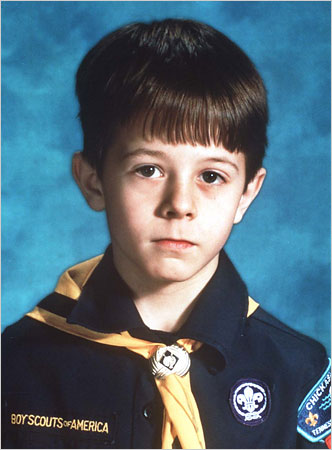|
History > 2009 > USA > Justice > States (I)



L to R: Michael Moore, Steve Branch, Christopher Byers.
HBO
Torn by 3 Lost Boys and 3 Convicted Youths
NYT
12.10.2009
https://www.nytimes.com/2009/10/12/us/12westmemphis.html

The three teenagers convicted of murdering three young boys:
from left, Jessie Misskelley Jr., Damien Echols and Jason Baldwin.
HBO
Torn by 3 Lost Boys and 3 Convicted Youths
NYT 12.10.2009
http://www.nytimes.com/2009/10/12/us/12westmemphis.html
West Memphis Journal
Torn by
3 Lost Boys
and 3 Convicted Youths
October 12, 2009
The New York Times
By SHAILA DEWAN
WEST MEMPHIS, Ark. — The patch of woods has been cleared, the shallow ditch
has been rerouted, the Blue Beacon Truck Wash has been torn down and 16 years
have passed. But though the setting where three 8-year-old boys were found
killed, naked and bound, in 1993 is unrecognizable, the crime still has the
power to dominate the front page of the small newspaper here and bring tight
smiles to the lips of civic boosters.
For years, outsiders have raised questions about the guilt of the three misfit
teenagers, Jason Baldwin, Damien Echols and Jessie Misskelley Jr., who were
convicted of the murders. But more recently, a steady dribble of new evidence
has begun to seep into the consciousness of West Memphis, eroding the once
nearly unanimous belief that those outsiders — including rock stars, HBO
filmmakers and the creators of “South Park” — did not know what they were
talking about.
To Shaun Hair, 30, who left West Memphis for college after the killings, it was
a jolt to hear friends and neighbors begin questioning the verdict. “I was like,
‘That’s stupid, quit buying the hype,’ ” he said.
But when Mr. Hair, who returned to the area in 1999 and now works as a criminal
defense lawyer, re-examined the case, he found it troubling. “If I were the
defense attorney,” he said, “I would want a retrial.”
Mr. Baldwin and Mr. Misskelley are serving life sentences; Mr. Echols is on
death row. Their convictions were based on an error-riddled confession by Mr.
Misskelley, who later recanted, and testimony about satanic cults. Scant
physical evidence was presented.
Since new DNA evidence drew renewed attention to the case in 2007, witnesses
have come forward with new information about the victims’ whereabouts in their
last hours and the knife that prosecutors suggested had been the murder weapon.
A “tip line” established by the defense fund for the West Memphis Three, as
their supporters call the convicted men, has attracted calls expressing the hope
for a new trial.
“Come on Arkansas, Supreme Court, give them the chance to prove their
innocence,” said one caller from a local area code in September, who did not
leave his name but said he did not mind if his comments were released.
Even the parents of the victims have had second thoughts. Early this month, Pam
Hobbs, whose son Steve Branch was killed, became the second parent to say she
believed that the West Memphis Three were innocent.
Still, the trial remains a delicate subject in West Memphis and its county,
Crittenden. The mayor of West Memphis, William H. Johnson, declined to be
interviewed about it. Linda Miller, who owns a health food store with her
husband and believes that the convictions were wrong, said she was wary of
speaking her mind because the issue was so “polarizing.”
In Little Rock, a two-year-old advocacy group, Arkansas Take Action, formed by a
pair of restaurateurs and Mr. Echols’s wife, Lorri Davis, to raise awareness of
the case, has held successful rallies and a candlelight vigil, and even drummed
up new evidence of jury misconduct. But it cannot claim a single member in
Crittenden County.
That is partly because residents have other preoccupations, including poverty
and tensions between black residents and the West Memphis Police Department. The
city’s population, about 27,000, has long been stagnant, and the housing boom
that overtook so many communities bypassed West Memphis.
Instead of a historic town square, West Memphis is largely defined by a
mile-and-a-half stretch where two interstates come together, funneling more than
30,000 trucks a day through the town and giving it a generic, transient air. The
once-wooded crime scene was sandwiched between that stretch and a residential
neighborhood called, as Lila Bailey, 68, a longtime resident, put it, “Garden
Something.”
The unusual murders — three children from three different families — were also a
deep trauma for a town small enough for only a degree or two of separation.
Questioning the results of the trial, some residents said, is tantamount to
questioning the local police, prosecutors and judges, and can feel like
disloyalty to the victims. Perhaps because they lived through it, few have
studied the case in the same detail as the West Memphis Three supporters have.
There is a strong urge to move on.
After the trial, said Ramona Taylor, a city councilwoman, “People felt
comfortable that the problem was resolved, and this was an anomaly. It was not
representative of our community or of our youth.”
Janine Earney, the director of the Crittenden Arts Council, said she becomes
angry every time she reads about the West Memphis Three — who, she points out,
were not even from West Memphis, but the next town.
“I don’t think anyone from the outside can look at what happened in this
community and judge it,” she said.
But a lack of open debate about the case does not mean that there are no deep,
if quiet, misgivings about the convictions. From his living room recliner, Mrs.
Bailey’s husband, Otto, offered his opinion. “I bet if you polled three-fourths
of West Memphis,” he said, “they would say those boys had nothing to do with
it.”
Torn by 3 Lost Boys and
3 Convicted Youths, NYT, 12.10.2009,
http://www.nytimes.com/2009/10/12/us/12westmemphis.html
Yale Killing Suspect Appears in Court
October 7, 2009
The New York Times
By SERGE F. KOVALESKI
and LIZ ROBBINS
NEW HAVEN — A former Yale University animal lab technician charged with
murdering a female graduate student last month appeared briefly in Connecticut
State Superior Court on Tuesday morning. Raymond Clark III, 24, the suspect in
the murder of the 24-year-old student Annie M. Le, did not enter a plea, and a
judge set a tentative date of Oct. 20 for a probable cause hearing.
After the appearance, which lasted only a few minutes, Mr. Clark’s lawyer Joseph
E. Lopez said in an interview that his client would eventually give a “pro forma
plea of not guilty.”
In court, Mr. Clark stood clean-shaven and dressed in bright orange prison garb,
his hands shackled in front of him, the short-sleeved jumpsuit exposing his
tattooed forearms.
Ms. Le was strangled on Sept. 8 and her body was stuffed into a wall of the lab
where she worked. She was found five days later — on what was supposed to be her
wedding day. Mr. Clark was arrested on Sept. 17, after forensic tests were
conducted, including DNA obtained from him with a court order that matched DNA
from the crime scene.
On Sept. 17, a judge sealed the arrest affidavit for 14 days, in response to a
request from state prosecutors who contended that unsealing it would impede the
continuing murder investigation. They have requested a continuation of the seal,
and Mr. Clark’s lawyers, Mr. Lopez and Beth A. Merkin, have also asked to keep
the warrant sealed, saying its release would impede Mr. Clark’s chances for a
fair trial.
On Tuesday morning, The Hartford Courant filed a motion to have the seal lifted
and the information released to the public.
Judge Roland D. Fasano set a date of Oct. 20 to discuss the motions filed. He
also set that date for Mr. Clark to report back to him about whether he will
waive the right to a probable cause hearing or request one.
A hearing could come as early as Oct. 20, but Mr. Lopez said that depended on
when the defense received the full package of the evidence from the
investigators.
“All I have is the search warrants and the arrest warrants,” Mr. Lopez said.
Ms. Merkin added in an interview that in murder cases a defendant enters a plea
either after waiving the right for a probable cause hearing or after a hearing
is conducted and probable cause is found.
In court on Tuesday, Mr. Clark appeared frightened; his only words were those he
mumbled to his two public defenders who flanked him. After the date was set, Mr.
Clark shuffled with his head down out of the court room, and was taken back to
MacDougall-Walker Correctional Institution in Suffield, Conn., a maximum-level
security prison. He is being held on $3 million bail.
When Mr. Clark was arrested, Chief James M. Lewis of the New Haven police said
that this was “an issue of workplace violence,” and not one specifically about
“urban crime, university crime, domestic crime.” Mr. Lewis said that Mr. Clark
and Ms. Le were not romantically involved, and that investigators might never
know the motive for the crime.
Mr. Clark first came under suspicion partly because of scratches on his chest
and scratches and bruises on his arms.
Some co-workers of Mr. Clark’s said that he was officious about following rules,
and had antagonized colleagues and research students he believed were cavalier
about rodent-handling regulations. One research team leader said he had
complained to Mr. Clark’s supervisor, but both the New Haven police and
university officials said they had no knowledge of complaints about Mr. Clark.
Serge F. Kovaleski reported from New Haven;
Liz Robbins reported from New
York.
Yale Killing Suspect
Appears in Court, NYT, 7.10.2009,
http://www.nytimes.com/2009/10/07/nyregion/07Yale.html
|